Address Fields
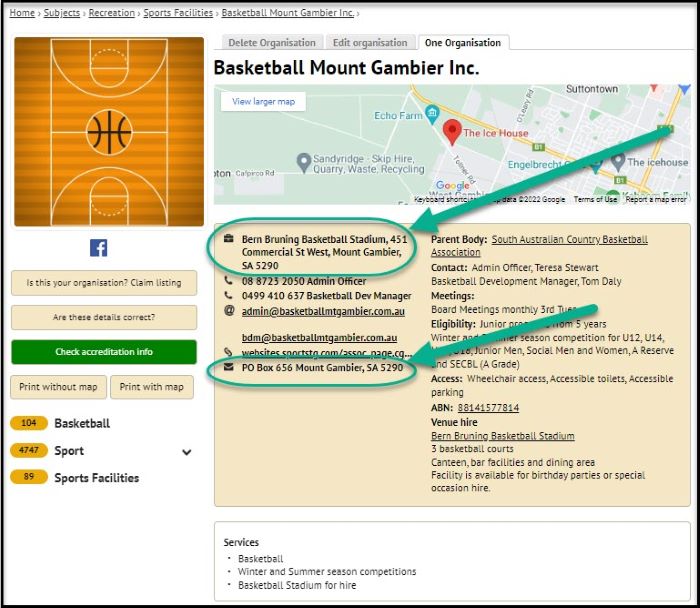
Example 1 Front-end:
a) Street Address
b) Postal Address
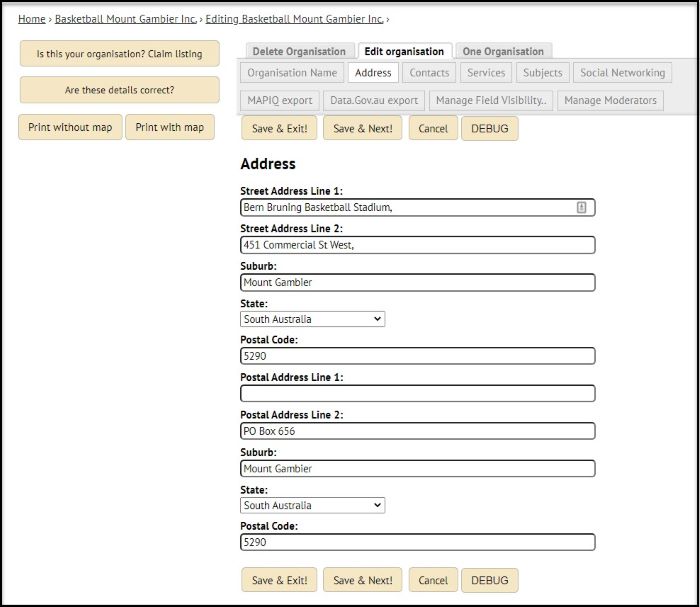
Example 1 Back-end:
a) Street Address
b) Postal Address
Address Fields Overview:
Address refers to a place where a community organisation can be reached, their street address provides a physical location and the postal address where mail can be sent to them.
Street Address - Location of activities
Street Address Fields refer to the address of a location where an organisation has their premises, such as the Waikerie Tennis Club, or places where an organisation regularly meets or practices, such as Berri Sports Stadium or Glassey Park or Morgan Institute.
Postal Address
Postal Addresses are an address to which mail can be sent, this is sometimes the same as the street address, however many organisations have their own post office box PO Box or send their mail care of the organisation they meet at C/O Mount Gambier Library.
Data Conventions & Standards
MARC 21 Format for Community Information Data defines conventions for community information records and contains descriptions of the data elements and examples.
In this case MARC 21 Community Information 270 Titles, Address Fields "address associated with the community information...mailing address and address corresponding to the physical location of a resource or facility."
The content of the data record is defined by standards outside MARC such as
METeOR (Metadata online registry) from the Australian Institute of Health & Welfare
In this case Standard Street Type Abbreviations
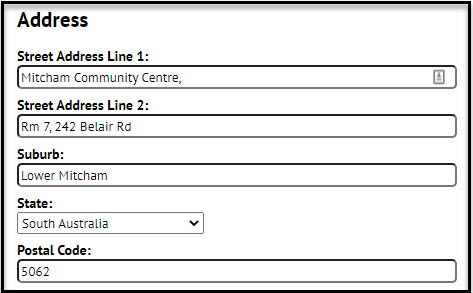
Street Address Fields:
Street Address Line 1: MARS Sporting Complex
Place Name (i.e. Senior Citizens Club, Waikerie Community Centre, Renmark Institute, Miller Reserve)
Can also be the name of the organisation listed: i.e. Loxton Golf Club otherwise leave blank.
Street Address Line 2: i.e. 3 Smith Rd - street types are abbreviated
Street Number (3) Name of Street Type (Smith) Street Type Abbreviation (Rd)
[Refer to METEOR for standard street type abbreviations] however only capitalise the first letter i.e. St, Ln, Bvd
Common examples include Street - St, Road - Rd, Court - Crt, etc.
Suburb: i.e. Marden - suburbs are written in full
Australia Post provides a list of Towns, Suburbs (and Postcodes) to cross reference the suburb
State: i.e. South Australia
In some cases, organisations operating in SA have their offices in Victoria or NSW and these states are chosen here as needed
Postal Code: i.e. 5070
Australia Post provides a list of Towns, Suburbs (and Postcodes) to cross reference the postcode (area code)
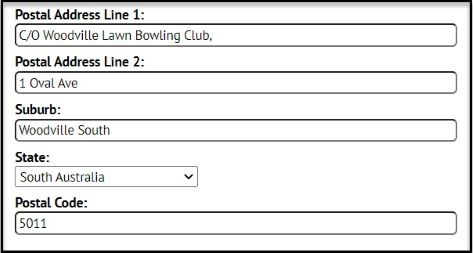
Postal Address Fields:
Postal Address
There are a number of postal delivery types and abbrieviations outlined by Australia Post
Care of - C/O
Care of Post Office - Care PO
Post Office Box - PO BOX
Roadside Mailbox - RMB
Postal Address Line 1: C/O Mitcham Community Centre
Place name, if the mail is addressed to a meeting or other venue (that is not the organisation itself) otherwise leave blank.
Postal Address Line 2: PO Box 456
Other examples can include postal delivery types above i.e. RMB 245
or the postal address may be the same as the street address. i.e. 3 Smith St
Suburb: Mitcham
Australia Post provides a list of Towns, Suburbs (and Postcodes) to cross reference the suburb
State: South Australia
In some cases, organisations operating in SA have their offices in Victoria or NSW and these states are chosen here as needed
Postal Code: 5062
Australia Post provides a list of Towns, Suburbs (and Postcodes) to cross reference the postcode (area code)
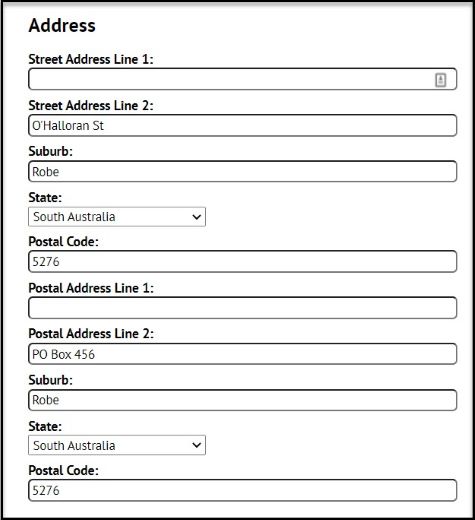

Challenging examples:
Australia Post provides information on Address Presentation Standards
Sub-unit (Flat/Unit/Appartment/Room Types)
Line 2: Flat 8, 24 Jones Tce
Line 2: Unit 7, 49 Young St
Line 2: Apt 4, 34 Belair Rd
Line 2: Rm 2, 242 Belair Rd
Complete Example: Line 1 Brixton Community Centre Line 2 Rm 2, 48 Brixton St Suburb: Christies Beach State: South Australia Postal Code:
Floor/Level
Line 1: Stafford House, Line 2: Level 1, 25 Leigh St
Line 1: Line 2: Basement, 35 Smith St
Complete Example: Line 1: Stafford House, Line 2: Level 1, 25 Leigh St Suburb: Adelaide State: South Australia Postal code: 5000
Common Address Examples:
Line 1: Mount Gambier Library, Line 2: 6 Watson Tce, Suburb: Mount Gambier State: South Australia Postal Code: 5290
Guidelines and explanations for Content
Corner or Via
Do not use Corner or Via, as they are not recognised as valid address components
If an organisation is at the corner of two streets: i.e. cnr The Parade & East Tce instead add the number and first street mentioned i.e. 432 The Parade.
Additional details i.e. room number are added to Line 2 and also under the meeting fields.
[Services --> Meetings--> Monthly, 2nd Mon 6pm, Brixton Community Centre, Rm 2, 48 Brixton St, Christies Beach]
Line 1 Blank
Fields in Addresses and Postal Addresses are left blank if a place is not named to allow us to utilise each the database fields as independent self-contained fields for greater usage.
Meetings at multiple venues
If an organisation meets at multiple venues, the primary venue, venue with the most sessions, or first venue listed is entered into the street address field and the others can be listed under Contacts - Branch Address field.
Meetings at member homes
Please note that if an organisation meets in member's homes, the suburb and postcode only are listed. This allows for privacy but also for people to have an estimate of an activity's location near them. (If a person lives in Adelaide they may search for a knitting group to contact only to find out later they are located in Port Lincoln 8 hours away!).
In addition, we avoid listing postal addresses that are home addresses for the same reasons, and it is best to address these groups postal box or care of their meeting place.
Women's Shelters
Women's shelters do not have their street addresses, suburbs, councils or electorates listed. People are generally referred to shelters from the parent body/head office contacts.
Reasons for street address listings
The reason that meeting places are listed are that the information is used by council for communication and research - they may look at organisations using a particular sports oval or community centre for service use or upgrading or in case of emergency evacuation to know who is meeting when, where and how to contact them.
Sign up for the newsletter!
Subscribe to our monthly newsletter to receive news, information and events for the community sector in SA.




